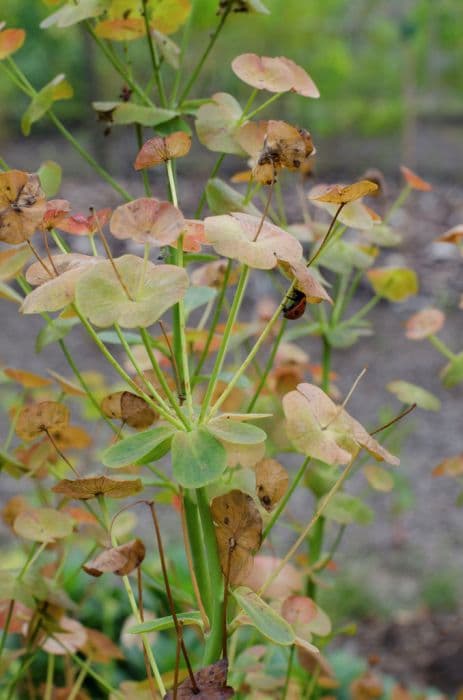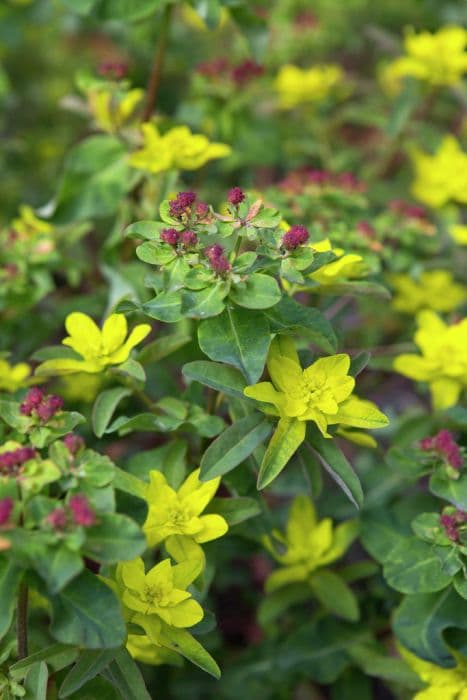Mediterranean Spurge Euphorbia characias Silver Swan = 'Wilcott' (PBR) (v)
![spurge [Silver Swan]](/_next/image?url=https%3A%2F%2Fplants-admin.emdemapps.com%2Fimages%2Fplants%2F%2Fimages%2F604b573f6c8f6.png&w=3840&q=75)
ABOUT
The plant known as the Silver Swan Spurge features a striking variegated foliage. The leaves boast a creamy white border that encases a core of blue-green, creating a sharp contrast that brings visual interest throughout the growing season. This unique coloring pattern gives the Silver Swan its name, as it resembles the grace and elegance of a swan. On closer inspection, each leaf is lance-shaped, which contributes to the plant's overall texture. When it blooms, it produces flowering bracts that typically hold an eye-catching combination of pale green and white colors. These bracts are tightly clustered, providing a robust and architectural dimension to the plant’s appearance. The Silver Swan Spurge has an upright growth habit, with its stems standing erect and firm, presenting the foliage and blooms in a proud stance.
About this plant
 Names
NamesSynonyms
Spurge, Silver Swan Spurge
Common names
Euphorbia characias 'Wilcott', Euphorbia characias subsp. wulfenii 'Wilcott'
 Toxicity
ToxicityTo humans
The Mediterranean Spurge is regarded as toxic to humans if ingested and can cause skin and eye irritation upon contact with its sap. The symptoms of poisoning if ingested may include nausea, vomiting, and diarrhea. The plant's sap contains diterpene esters which can lead to skin irritation, redness, swelling, and blisters. If the sap gets into the eyes, it can cause severe pain and possible eye damage, necessitating immediate medical attention.
To pets
The Mediterranean Spurge is toxic to pets if ingested, causing symptoms such as vomiting, diarrhea, excessive drooling, and abdominal pain. Contact with the plant's sap can lead to skin and mucous membrane irritation. If the sap comes into contact with a pet's skin, it may cause redness, swelling, and pain. If the sap gets into the eyes, it can cause intense pain and inflammation, possibly resulting in temporary or permanent blindness. Immediate veterinary care is advisable if a pet ingests or comes into contact with the sap of this plant.
 Characteristics
CharacteristicsLife cycle
Perennials
Foliage type
Evergreen
Color of leaves
Variegated
Flower color
Varies
Height
2-3 feet (60-90 cm)
Spread
2-3 feet (60-90 cm)
Plant type
Shrub
Hardiness zones
8
Native area
Mediterranean
Benefits
 General Benefits
General Benefits- Ornamental Value: Euphorbia characias Silver Swan is prized for its striking variegated foliage that adds visual interest to garden landscapes.
- Drought Tolerance: Once established, it is very tolerant of drought conditions, making it ideal for water-wise and xeriscape gardens.
- Low Maintenance: It requires minimal care, making it suitable for gardeners who prefer plants that do not need a lot of attention.
- Seasonal Interest: It produces distinctive blooms in the spring, adding a seasonal highlight to gardens.
- Deer Resistance: The plant is generally resistant to deer browsing, which is beneficial for gardens in areas with high deer populations.
- Pest Resistance: It is known to have few problems with pests and diseases, leading to fewer needs for chemical treatments.
- Longevity: The plant is perennial in suitable climates, ensuring a lasting presence in the garden year after year.
- Easy Propagation: It can be easily propagated from cuttings, making it simple for garden enthusiasts to share and expand their collection.
- Structural Plant: Its upright form provides excellent structure and contrast when planted among other garden plants.
- Versatility: It can be used in a variety of garden settings, including borders, rock gardens, or as a specimen plant.
 Medical Properties
Medical PropertiesThis plant is not used for medical purposes.
 Air-purifying Qualities
Air-purifying QualitiesThis plant is not specifically known for air purifying qualities.
 Other Uses
Other Uses- Spurge 'Silver Swan' can be used in floral arrangements for its striking foliage and architectural form.
- Dried seed pods from spurge 'Silver Swan' may be used in craft projects or as part of decorative displays.
- The plant's sap can be used as a fish poison in traditional fishing practices, though this is not a recommended or legal use in many areas.
- Spurge 'Silver Swan' can serve as a host plant for certain types of insects, providing a habitat and food source within an ecological garden setting.
- The distinctive look of spurge 'Silver Swan' makes it a useful plant for photography projects, particularly macro photography.
- Its resilience and low water requirements can make it a suitable plant for xeriscaping and sustainable landscaping projects.
- The plant can be utilized as part of a living fence or boundary due to its height and growth habit.
- Spurge 'Silver Swan' may be used in educational settings to teach about drought-resistant plants or the Euphorbiaceae family.
- Seed collecting from spurge 'Silver Swan' can be a hobby for plant enthusiasts interested in propagation and breeding.
- The textural contrast of the plant's leaves and bracts can be used in garden design to provide visual interest and highlight other plants around it.
Interesting Facts
 Feng Shui
Feng ShuiThe Spurge is not used in Feng Shui practice.
 Zodiac Sign Compitability
Zodiac Sign CompitabilityThe Spurge is not used in astrology practice.
 Plant Symbolism
Plant Symbolism- Resilience: Euphorbia or Spurge plants, in general, are known for their ability to adapt and thrive in various conditions, symbolizing resilience and perseverance.
- Protection: Many Euphorbias contain a milky latex that is toxic and can cause irritation. This has led to the belief that the plant symbolizes protection and the need to ward off negative influences.
- Endurance: The Euphorbia's robust nature and long-lasting qualities represent enduring power through challenging situations.
- Purification: The toxicity and the medicinal properties ascribed to some Euphorbias have given them a symbolic link to purification and the clearing of negative energy.
- Healing: Historically, various species of Euphorbia have been used in traditional medicine, symbolizing healing and the treatment of ailments.
 Water
WaterTo water the Spurge 'Silver Swan', ensure it receives thorough watering to moisten the soil entirely without causing waterlogging. Typically, the plant needs watering once a week, but this should be adjusted based on the weather and soil dryness. During the growing season, maintain consistently moist soil, which might mean watering amounts of approximately half a gallon every seven to ten days. In winter, reduce watering to when the soil feels dry to the touch, possibly cutting down to a quarter gallon every two to three weeks, careful to avoid overwatering which can lead to root rot.
 Light
LightThe Spurge 'Silver Swan' thrives in full sun to part shade conditions. The best spot for this plant would be where it receives at least six hours of direct sunlight daily. However, it can also tolerate some light shade, especially in hotter climates where afternoon shade can prevent scorching.
 Temperature
TemperatureThe Spurge 'Silver Swan' prefers temperate climates and is hardy in temperatures ranging from 30°F to 86°F. The ideal temperature range for this perennial falls within 60°F to 75°F for optimal growth. It’s important to avoid exposure to extreme cold or frost which can damage the plant.
 Pruning
PruningPrune Spurge 'Silver Swan' in late winter or early spring to remove any winter-damaged foliage and to maintain the shape of the plant. Additionally, deadhead spent flowers to encourage a second bloom and tidy up the plant’s appearance. Pruning is generally done annually before the onset of the new growing season.
 Cleaning
CleaningAs needed
 Soil
SoilSpurge 'Silver Swan' thrives in a well-draining soil mix with plenty of gritty material, like coarse sand or perlite, to promote aeration and prevent waterlogging. The best soil pH for this plant is neutral to slightly alkaline, ranging from 6.5 to 7.5. To ensure optimal growth, the soil should also be fertile and enriched with organic matter.
 Repotting
RepottingSpurge 'Silver Swan' does not require frequent repotting and can be done every 2 to 3 years or when the plant has outgrown its current container. It is best to repot in the spring, giving the plant time to establish in the new pot before the growing season.
 Humidity & Misting
Humidity & MistingSpurge 'Silver Swan' is fairly tolerant of different humidity levels and does well in average room humidity. This plant does not need high humidity and can thrive in dry conditions, making it suitable for most indoor environments.
 Suitable locations
Suitable locationsIndoor
Provide bright light, avoid overwatering, and ensure drainage.
Outdoor
Choose a sunny spot, well-draining soil, and shelter from harsh winds.
Hardiness zone
7-10 USDA
 Life cycle
Life cycleEuphorbia characias 'Silver Swan', commonly known as Mediterranean Spurge, begins its life cycle as a seed, which germinates in spring when soil temperature and moisture conditions are suitable. The seedling stage follows, in which the plant develops its first true leaves and establishes a root system. As the plant enters the vegetative growth phase, it forms a robust, bushy structure with variegated foliage, silver-edged leaves, and stems. This perennial then progresses to the flowering stage, usually in late winter to spring, producing distinctive greenish-yellow inflorescences with a central chartreuse eye. After pollination and seed set, the plant may go through a period of dormancy, particularly in regions with hot, dry summers or cold winters, though in milder climates it may remain evergreen. The plant completes its cycle by producing new seeds, which are then dispersed, and the mature plant may die back after several years, though it can also self-seed and perpetuate in the garden.
 Propogation
PropogationPropogation time
Spring to Summer
Euphorbia characias 'Silver Swan', also known as Spurge, is typically propagated by cuttings. The best time to take cuttings for propagation is in late spring or early summer when the plant is actively growing. For optimal results, select a healthy stem, preferably with new growth, and cut a piece about 4 to 6 inches (approximately 10 to 15 centimeters) long. The cut should be made just below a leaf node, and the lower leaves should be removed to expose a clean stem section. The cut end can be dipped in rooting hormone to enhance root development, then planted in a well-draining soil mix. The cuttings should be kept in warm conditions with indirect light, ensuring the soil stays moist but not waterlogged. Roots typically develop within a few weeks, and once established, the young plants can be transplanted into their final growing location.









